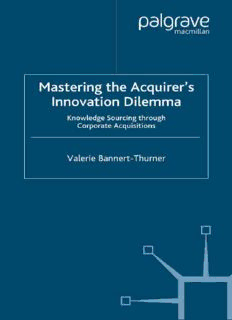
Mastering the Acquirer’s Innovation Dilemma: Knowledge Sourcing through Corporate Acquisitions PDF
Preview Mastering the Acquirer’s Innovation Dilemma: Knowledge Sourcing through Corporate Acquisitions
Mastering the Acquirer’s Innovation Dilemma This page intentionally left blank Mastering the Acquirer’s Innovation Dilemma Knowledge Sourcing through Corporate Acquisitions Valerie Bannert-Thurner in association with the European Institute for Technology and Innovation Management © Valerie Bannert-Thurner 2005 All rights reserved.No reproduction,copy or transmission of this publication may be made without written permission. No paragraph of this publication may be reproduced,copied or transmitted save with written permission or in accordance with the provisions of the Copyright,Designs and Patents Act 1988,or under the terms of any licence permitting limited copying issued by the Copyright Licensing Agency,90 Tottenham Court Road,London W1T 4LP. Any person who does any unauthorized act in relation to this publication may be liable to criminal prosecution and civil claims for damages. The author has asserted her right to be identified as the author of this work in accordance with the Copyright, Designs and Patents Act 1988. First published in 2005 by PALGRAVE MACMILLAN Houndmills,Basingstoke,Hampshire RG21 6XS and 175 Fifth Avenue,New York,N.Y.10010 Companies and representatives throughout the world. PALGRAVE MACMILLAN is the global academic imprint of the Palgrave Macmillan division of St.Martin’s Press,LLC and of Palgrave Macmillan Ltd. Macmillan® is a registered trademark in the United States,United Kingdom and other countries.Palgrave is a registered trademark in the European Union and other countries. ISBN 978-1-349-52439-6 ISBN 978-0-230-50813-2 (eBook) DOI 10.1057/9780230508132 This book is printed on paper suitable for recycling and made from fully managed and sustained forest sources. A catalogue record for this book is available from the British Library. Library of Congress Cataloging-in-Publication Data Bannert-Thurner,Valerie,1978– Mastering the acquirer’s innovation dilemma :knowledge sourcing through corporate acquisitions / by Valerie Bannert-Thurner. p.cm. Includes bibliographical references and index. 1.Consolidation and merger of corporations.2.Technological innovations. 3.Strategic planning.I.Title. HD2746.5.B34 2005 658.1(cid:1)62—dc22 2005047468 10 9 8 7 6 5 4 3 2 1 14 13 12 11 10 09 08 07 06 05 To Philipp This page intentionally left blank Contents List of Figures xi List of Best Practices xv List of Abbreviations xvi Preface xix 1 Introduction 1 1.1 Relevance of the Topic – Acquisitions in Innovation-driven Industries 1 1.2 Acquisition Performance from a Technology-based Perspective 5 1.3 Call from Practice – Mastering the Innovation Dilemma 7 1.4 Objectives, Research Approach and Content of the Book 9 2 Technology,Innovation and their Management 13 2.1 Terms and Definitions: Technology-based Value Creation 13 2.2 Technology Management 17 2.2.1 Integrated technology management 17 2.2.2 Basic elements of the integrated technology management 18 2.2.3 Main tasks of the integrated technology management 23 2.3 Innovation Management 26 2.4 Conclusion 27 3 Introduction to Corporate Acquisitions 28 3.1 Terms and Definitions: Corporate Acquisitions 28 3.2 Acquisition Types 29 3.3 Acquisitions as a Means of Value Creation 30 3.4 Acquisitions as a Business Strategic Path 30 3.5 Conclusion 31 vii viii Contents 4 Case Studies from Reality:Technology-based Value Creation in Real-life Acquisitions 32 4.1 Theoretical Model to Investigate Technology-based Value Creation 33 4.2 Selection of the Case Studies and Data Collection 34 4.3 Cases from Reality 37 4.3.1 Case 1: Hilti–Ammann Lasertechnik acquisition 37 4.3.2 Case 2: Fillpack–Aseptofill acquisition 46 4.3.3 Case 3: Phonak–Unitron acquisition 57 4.3.4 Case 4: Unaxis–Plasma-Therm acquisition 69 4.3.5 Case 5: Starrag–Heckert acquisition 86 4.4 Conclusion on Cases from Reality 99 5 Model of Reality:A New Understanding of Technology-based Value Creation in Corporate Acquisitions 100 5.1 Technology-based Value Creation – Quick gains and Long-term Success 101 5.1.1 Innovation and resource deployment 101 5.1.2 Quick gains and long-term successes 102 5.2 Acquisition Type – Indeed not all M&As are Alike – and that matters 104 5.2.1 Acquisition characteristics 105 5.2.2 Acquisition types and strategies 110 5.3 Initial Conditions – Necessary, However Insufficient, Conditions 113 5.3.1 Technology-based value creation potential 113 5.3.2 Acquisition capability 119 5.3.3 Strategic fit 121 5.3.4 Contextual fit 123 5.4 Strategy Processes – The Appropriate Acquisition and Integration Processes 125 5.4.1 The impact of the acquisition process on technology-based value creation 126 5.4.2 The impact of the integration process on technology-based value creation 129 5.5 External Developments 135 5.6 Conclusion from the New Understanding 136 Contents ix 6 Technology-based Strategic Acquisition and IntegrationManagement 137 6.1 Developing the Concept 138 6.2 Overview of the Concept 139 6.2.1 Phases of the technology-based acquisition and integration management 139 6.2.2 Layers of the technology-based acquisition and integration management 141 6.2.3 Technology-based strategic acquisition and integration management on the normative, strategic and operational level 145 6.2.4 Integrating the technology and innovation management into the AIM 145 6.3 The Detailed Concept 145 6.3.1 Strategic planning 148 6.3.2 Company screening 154 6.3.3 Acquisition and integration strategy development 166 6.3.4 Due diligence 202 6.3.5 Integration planning 220 6.3.6 Strategy implementation 228 6.4 Conclusion from Technology-based Strategic Acquisition and Integration Management 234 7 Management Principles 237 7.1 Management Principles for a New Understanding 237 7.1.1 Management Principle 1: Wheel of technology-based value creation 237 7.1.2 Management Principle 2: Innovativeness cannot be bought 238 7.1.3 Management Principle 3: Willingness to change as key initial condition 238 7.1.4 Management Principle 4: Creative destruction of innovation context 239 7.2 Management Principles for a New Concept 239 7.2.1 Management Principle 5: Technology concerns as basic fundamental 239 7.2.2 Management Principle 6: Holistic, systemic and integrative concept 240 7.2.3 Management Principle 7: Prospective perspective 240 7.3 Management Principles for Implementation 241 7.3.1 Management Principle 8: Implementation requires a new awareness of acquisitions 241
